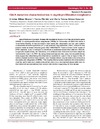Identificador persistente para citar o vincular este elemento:
https://accedacris.ulpgc.es/jspui/handle/10553/21220
| Campo DC | Valor | idioma |
|---|---|---|
| dc.contributor.author | Bilbao-Sieyro, Cristina | en_US |
| dc.contributor.author | Florido, Yanira | en_US |
| dc.contributor.author | Gómez Casares, María Teresa | en_US |
| dc.contributor.other | GOMEZ CASARES, MARIA TERESA | - |
| dc.contributor.other | BILBAO SIEYRO, CRISTINA | - |
| dc.date.accessioned | 2017-03-31T02:30:54Z | - |
| dc.date.accessioned | 2018-03-16T09:14:14Z | - |
| dc.date.available | 2017-03-31T02:30:54Z | - |
| dc.date.available | 2018-03-16T09:14:14Z | - |
| dc.date.issued | 2016 | en_US |
| dc.identifier.issn | 1949-2553 | en_US |
| dc.identifier.uri | https://accedacris.ulpgc.es/handle/10553/21220 | - |
| dc.description.abstract | Identification of somatic frameshift mutations in exon 9 of the calreticulin gene (CALR) in myeloproliferative neoplasms (MPNs) in December of 2013 has been a remarkable finding. It has provided a new molecular diagnostic marker, particularly in essential thrombocythemia (ET) and primary myelofibrosis (PMF), where is the second most common altered gene after JAK2V617F. | es |
| dc.format | application/pdf | es |
| dc.language | eng | en_US |
| dc.relation.ispartof | Oncotarget | en_US |
| dc.rights | by-nc-nd | es |
| dc.source | Oncotarget [ISSN 1949-2553], v. 7 (33), p. 52614-52617 | en_US |
| dc.subject | 32 Ciencias médicas | es |
| dc.subject | 320504 Hematología | es |
| dc.subject.other | CALR | es |
| dc.subject.other | myeloproliferative neoplasms | es |
| dc.subject.other | type-1/2-like mutations | es |
| dc.title | CALR mutation characterization in myeloproliferative neoplasms | en_US |
| dc.type | info:eu-repo/semantics/Article | en_US |
| dc.type | Article | en_US |
| dc.identifier.doi | 10.18632/oncotarget.10376 | |
| dc.identifier.scopus | 84982306529 | - |
| dc.identifier.isi | 000385433000001 | - |
| dcterms.isPartOf | Oncotarget | |
| dcterms.source | Oncotarget[ISSN 1949-2553],v. 7 (33), p. 52614-52617 | |
| dc.contributor.authorscopusid | 56294291600 | |
| dc.contributor.authorscopusid | 36953039500 | |
| dc.contributor.authorscopusid | 6602513846 | |
| dc.identifier.crisid | 17907;-;- | - |
| dc.description.lastpage | 52617 | - |
| dc.description.firstpage | 52614 | - |
| dc.relation.volume | 7 | - |
| dc.investigacion | Ciencias de la Salud | es |
| dc.rights.accessrights | Acceso libre | es |
| dc.type2 | Artículo | en_US |
| dc.identifier.wos | WOS:000385433000001 | - |
| dc.contributor.daisngid | 2205075 | - |
| dc.contributor.daisngid | 5970874 | - |
| dc.contributor.daisngid | 796368 | - |
| dc.identifier.investigatorRID | R-6060-2018 | - |
| dc.identifier.investigatorRID | R-6779-2018 | - |
| dc.contributor.wosstandard | WOS:Bilbao-Sieyro, C | |
| dc.contributor.wosstandard | WOS:Florido, Y | |
| dc.contributor.wosstandard | WOS:Gomez-Casares, MT | |
| dc.date.coverdate | Agosto 2016 | |
| dc.identifier.ulpgc | Sí | es |
| dc.description.sjr | 1,927 | |
| dc.description.jcr | 5,168 | |
| dc.description.sjrq | Q1 | |
| dc.description.jcrq | Q1 | |
| item.grantfulltext | open | - |
| item.fulltext | Con texto completo | - |
| crisitem.author.dept | Departamento de Morfología | - |
| crisitem.author.dept | Departamento de Ciencias Médicas y Quirúrgicas | - |
| crisitem.author.orcid | 0000-0002-4796-1445 | - |
| crisitem.author.orcid | 0000-0003-0505-5126 | - |
| crisitem.author.fullName | Bilbao Sieyro, Cristina | - |
| crisitem.author.fullName | Gómez Casares, María Teresa | - |
| Colección: | Artículos | |
Citas SCOPUSTM
10
actualizado el 08-jun-2025
Citas de WEB OF SCIENCETM
Citations
7
actualizado el 08-jun-2025
Visitas
81
actualizado el 02-mar-2024
Descargas
155
actualizado el 02-mar-2024
Google ScholarTM
Verifica
Altmetric
Comparte
Exporta metadatos
Los elementos en ULPGC accedaCRIS están protegidos por derechos de autor con todos los derechos reservados, a menos que se indique lo contrario.
